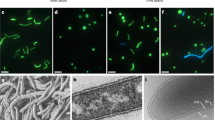Abstract
DURING investigations of the unsaponifiable fraction of bakers' yeast (Distillers Co., Ltd.) by two-dimensional chromatography1, a heavy spot was observed on the papers in a position very close to that expected for ubichromenol-30, which substance is present only in very small amounts in this yeast (preceding communication). The new substance was—like ubichromenol-30—slowly reducing to ferric chloride—dipyridyl; but, on papers pretreated with zinc carbonate containing a trace of sodium fluorescein2 is weakly fluorescent under ultra-violet light, whereas the ubichromenol is observed as a quenching spot under the same conditions. By a combination of adsorption and reverse-phase partition paper chromatography, a few milligrams of the substance were obtained in a reasonable state of purity. Long runs in two reverse phase paper systems (a) liquid paraffin/95 per cent ethanol, and (b) olive oil/95 per cent ethanol, clearly distinguished the new substance from ubichromenol-30; the R F values for these two substances in the latter system were 0.64 and 0.46, respectively. The new substance had absorption maxima at 255 and 282 mµ., with minima at 267 and 315 mµ (in ethanol). In the presence of dilute ethanolic alkali, the 282-mµ. peak disappeared and a new peak at 345 mµ appeared. Well-defined isosbestic points occurred at 271 mµ and 322 mµ. These changes are similar to those described3 for ubichromenol-50, with some displacement of the points, and probably indicate the presence of a phenolic OH grouping as in the latter. The infra-red spectrum had bands at ν2,899, 2,809, 1,455, 1,373, 1,261, 1,208 and 1,059 cm.−1, similar to those found in a specimen of ubichromenol-50 (kindly given by Prof. R. A. Morton). Substance 282 (so-called because the single peak at 282 mµ characteristically distinguishes it from the ubichromenols) was chromatographically distinct from the fluorescent substance, 3-formylindole, which is present in certain animal tissues4 and has λmax. 282 (in cyclohexane) and λmax 294 (in ethanol). Substance 282 was found to be strongly active, like α-tocopherol, in the in vitro erythrocyte hæmolysis test.
This is a preview of subscription content, access via your institution
Access options
Subscribe to this journal
Receive 51 print issues and online access
$199.00 per year
only $3.90 per issue
Buy this article
- Purchase on Springer Link
- Instant access to full article PDF
Prices may be subject to local taxes which are calculated during checkout
Similar content being viewed by others
References
Diplock, A. T., Green, J., Edwin, E. E., and Bunyan, J., Biochem. J., 76, 563 (1960).
Green, J., J. Sci. Food Agric., 9, 801 (1958).
Laidman, D. L., Morton, R. A., Paterson, J. Y. F., and Pennock, J. F., Biochem. J., 74, 541 (1960).
Morton, R. A., and Fahmy, N. I., Biochem. J., 72, 99 (1959).
Forbes, M., and György, P., J. Nutrit., 63, 461 (1957).
Meisinger, M. A. P., Kuehl, F. A., Rickes, E. L., Brink, N. G., and Folkers, K., J. Amer. Chem. Soc., 81, 4979 (1959).
Author information
Authors and Affiliations
Rights and permissions
About this article
Cite this article
EDWIN, E., GREEN, J., DIPLOCK, A. et al. An Unidentified Ubichromenol-like Lipid Constituent of Bakers' Yeast. Nature 189, 750–751 (1961). https://doi.org/10.1038/189750a0
Issue Date:
DOI: https://doi.org/10.1038/189750a0
Comments
By submitting a comment you agree to abide by our Terms and Community Guidelines. If you find something abusive or that does not comply with our terms or guidelines please flag it as inappropriate.



